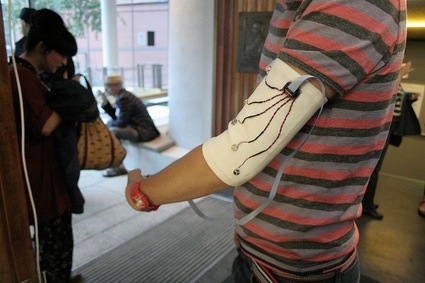Bits and pieces of September 2011
Synaptics Fuse Mobile Phone Concept, link and video
Old news from 2010, but still interesting as a concept piece. The Fuse mobile phone concept is a collaboration among Synaptics, Texas Instruments (TI), Immersion, TheAlloy, and TAT – The Astonishing Tribe. The device solves key human interface challenges for current-generation handsets, primarily single-handed usage.
AHNE – Audio-Haptic Navigation Environment, Sound and Physical Interaction from Helsinki, link
It is an audio-haptic user interface that allows the user to locate and manipulate sound objects in 3d space with the help of audio-haptic feedback.The user is tracked with a Kinect sensor using the OpenNI framework and OSCeleton.The user wears a glove that is embedded with sensors and a small vibration motor for the haptic feedback.

Sticky Data device from The Institute for Boundary Interactions, link
The most stimulating thing about being able to sense geo-located data is the thought that you are physically feeling traces of people’s experiences in the same place where they happened. We think this gives an extra sense of connection to a place, even if only for a moment. [text blurb and image from We Make Money Not Art]
Glove to improve sense of touch, from Georgia Tech, link
Previous research has shown that adding an appropriate amount of white noise — a concept called stochastic resonance — can improve sight, hearing, balance control and touch, but the white noise had not been incorporated into a wearable device. The Georgia Tech prototype is believed to be the first wearable stochastic resonance device, attaching to the fingertip to improve the sense of touch.
Quanser High Definition Haptic Device, link
Haptic devices use high bandwidth servo motors and encoder feedback to simulate real-life situations like surgery. (Another case of “refining haptics via technological advances”, not bad necessarily)
Simulating The Sensation Of An Object Passing Through Your Hands, link and video
The Kajimoto research group at the University of Electro-Communications is developing a device that simulates the sensation of something passing through your hand. It is proposed to improve the sense of realism in games, and uses a vibration mechanism to create the illusion.

Comments are closed.